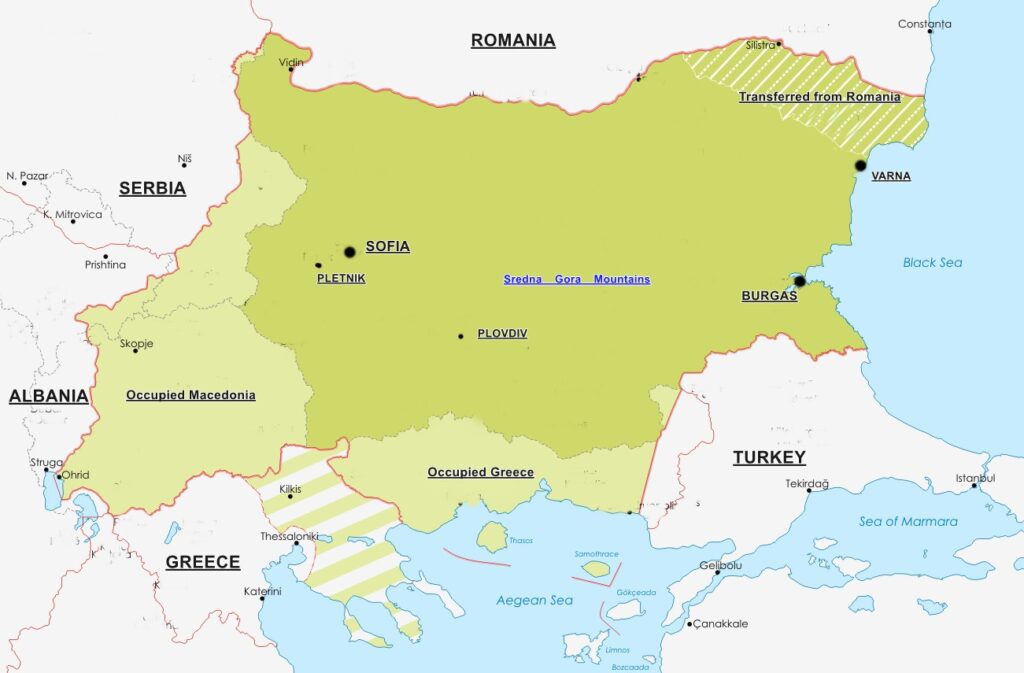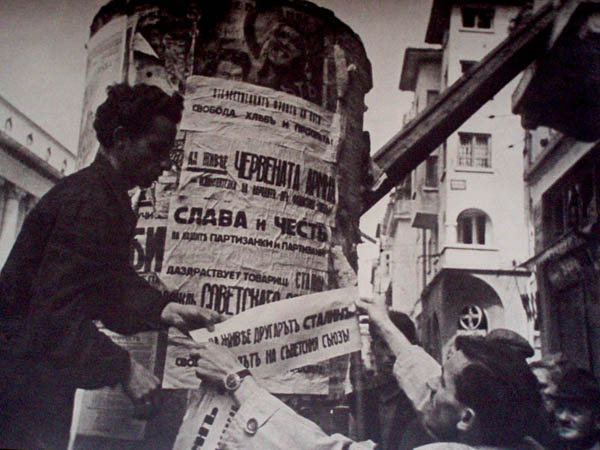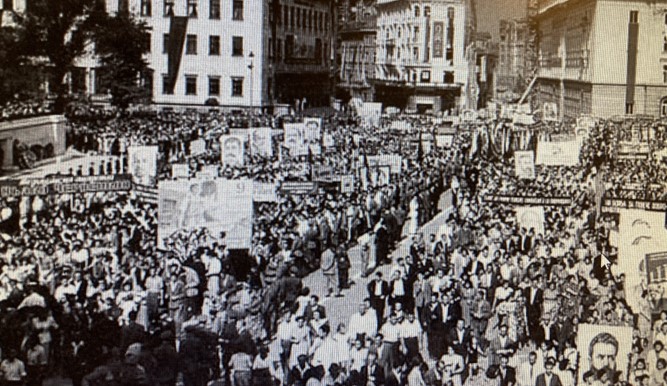Andy Ford (Warrington South Labour member) continues his occasional series of articles marking 80-year anniversaries of events in Soviet military history in WW2.
[Featured photo shows a Communist demonstration in Sofia – 1944]
On September 8th 1944, Bulgaria, which had been an ally of Nazi Germany, reversed its position and declared war on Germany. German troops were forced to leave, or in some cases interned and transferred to the Soviets.
Bulgaria had begun the war as neutral but, as Hitler moved against Yugoslavia and Greece, it was forced into alliance with him in March 1941, although many Bulgarians despised the forced alliance. As a reward, Bulgaria was awarded those parts of Greece, Macedonia and Yugoslavia with mixed Bulgarian, Greek, Albanian and Serb populations, which temporarily gave the government a nationalistic boost. The country even symbolically declared war on Britain and the USA, but when the Nazis invaded the USSR, the Bulgarians refused to take part.
Bulgaria’s partisan movement
Bulgaria was the only German-allied country to see the birth of a partisan movement to oppose government co-operation with the Nazis. The backbone of the partisan movement, of course, was the Communist Party, which had been driven underground in 1934. After the German defeat at Stalingrad, the Party found that they had the support to begin a low level insurgency in 1943, which involved seizing weapons and killing isolated regime officials.

An indication of how low level the insurgency was can be seen in their hold up of a train in the Sredna Gora Mountains, where one of the passengers was the Vice President of Bulgaria. When an army rescue force appeared, the partisans were put to flight, but the rescue force consisted of one officer and five soldiers!
The partisans were really more of a possible, than an actual, threat. Their impact was increased by the massive exaggeration of their strength by German intelligence, who estimated one band as of 3,000 fighters when it was in reality only 150. But as the Red Army got closer, the numbers of partisans climbed from 4,000 in early 1944 to 10,000 by the summer and the scope of their operations increased, with ambushes of police units, seizures of weapons and brief occupations of towns, especially in the mountains and rural areas.
Police and army terror in the villages suspected of harbouring the partisans only served to alienate the rural population and begin to create a base for guerrilla war. In mid-1943, the Communists launched the ‘Fatherland Front’ as a broad opposition, which included the left of the Agrarian Party, the Social Democrats and the nationalistic Zveno movement, but the Communists maintained their position as the main armed group opposing the government.
The effects of events in Romania
Romania’s sudden surrender to the Soviet Union and change of sides in late August 1944 [see article here] led to the sudden realisation in Bulgarian government circles that they had backed the wrong side. In August, the Prime Minister made a declaration that the country would now observe “strict neutrality”.
However, on the 30 August, this was rejected by the Soviets, who pointed to the presence of thousands of German troops on Bulgarian soil, and the Bulgarian Army’s continued military operations against Communist partisans in Yugoslavia. The Prime Minister had no option but to resign, to be replaced by Kosta Muraniev from the right wing of the Agrarian Party.
Muraniev could see the ground slipping away from under the government, which had been a monarchist dictatorship since 1934, and he hastened to shore up support. On 3 September, executions of political prisoners were banned, and the next day, he announced an amnesty for political prisoners; the dissolution of fascist organisations; withdrawal of Bulgarian troops from Serbia; and negotiations with the Allies for an armistice.
The same day, the Red Army reached the Danube (the border between Romania and Bulgaria) and stopped there, awaiting developments. But everyone knew they were just two days away from Sofia, the Bulgarian capital.
Retreating German formations began to be harassed and even arrested and interned, with fighting between formerly-allied German and Bulgarian units in occupied Macedonia erupting on 4 September. The Soviets were not impressed with the Bulgarian government’s weak and vacillating treatment of the German forces, and suddenly declared war on 5 September.
The Bulgarian revolution begins
This was the signal for a full-on revolutionary upsurge in Bulgaria, beginning with a demonstration of students in front of the Ministry of Justice, demanding freedom for political prisoners, who then marched to the Soviet embassy, attacking the German embassy along the way. The next day, a much larger demonstration protested outside the hotel housing German officers, who drew their weapons and fired into the crowd, with police arresting hundreds of demonstrators.
On 6 September, rebellious sailors freed imprisoned communists in the port of Varna and a tram strike took hold in the capital. That the workers had lost their fear of the dictatorship, and its police, was shown in a huge strike of the tobacco workers (who in 1940 had led Bulgaria’s last serious strikes) followed by a nationwide railway strike. On September 7, coal miners in Pernik also stopped work. Strikers stormed the prisons and set free the inmates. Muraniev’s government was suspended in mid-air.
On the 8 September, the Red Army crossed the Danube, and were welcomed as liberators in towns and villages across northern Bulgaria.
The journal ‘Fourth International’ reported that,
“In Bulgaria, the entrance of the Red Army troops was the signal for a mass uprising. We read in the dispatches of the Red Flag waving over the government buildings as well as over thousands of homes. We read of the immediate arrests of the fascists by the armed people and the holding of huge mass demonstrations in the cities; of a railway strike that paralyzed the government; of the military authorities losing effective control.”
Desperately, Muraniev tried to maintain his, and the capitalists’, hold on power. On September 6 the head of the German military mission was told that all German troops must be out of Bulgaria by midnight on the 7th; the anti-Jewish laws were repealed, and eventually, late on 8 September, Bulgaria declared war on Germany. The country thus found itself in the unique position, for 24 hours, of being at war with Germany, Britain, the USA, and the USSR at the same time!

Now whole regiments and garrisons across the country mutinied and arrested their officers, and the Bulgarian soldiers occupying northern Greece began to desert their posts. On September 9 the Soviets announced a ceasefire, issuing leaflets and posters proclaiming that “The Red Army has no intention of fighting the Bulgarian people”.
Before the Red Army reached the capital, the Fatherland Front decided to organise an uprising in Sofia, and throw the Muraniev government out of power. At 2 pm on the 9th September a mixed force of mutinous soldiers, military cadets and partisans seized key points across the capital and arrested Muraniev and his ministers. It was all done in an hour. The dictatorship that had ruled Bulgaria since 1934 was gone in a puff of smoke.
Revolution blocked by Stalin and the Stalinists
But a workers revolution was not at all what Stalin wanted. ‘Fourth International’ wrote:
“The New York Times correspondent, Joseph M. Levy, telephoning from Sofia on September 21, reported that ‘In a few of the provinces … pillaging and even killing of the suspected Fascists occurred, but these acts were soon stopped by the [Communist] militia’”
Where workers or peasants had removed fascist officials from their posts, the Red Army compelled them to reinstate them to their posts. In the words of ‘Fourth International’:
“The new government immediately undertook to “pacify” the situation and re-establish “order.” John Chamley, special correspondent of the London News Chronicle, reported that the government printed an appeal ordering soldiers to return to their barracks. They announced that part of the militia would be absorbed into the regular army while all armed civilians were ordered to report to designated places and surrender their arms. Thus the new government, propped up by the bayonets of the Red Army, began its work in the classic manner of all counterrevolutions – the campaign to disarm the insurgent masses and to restore capitalist “law and order.”
It is clear that the intervention of the Red Army served two purposes: firstly the military one of cutting off Nazi forces in Greece and throwing them out of Yugoslavia and the Balkans; but also that of preventing an independent socialist Bulgaria emerging from the ruins of the monarchist dictatorship. Events in Bulgaria therefore followed the same pattern as the failure to aid the Slovakian National Uprising [see article here], and the betrayal of the Warsaw Uprising.



